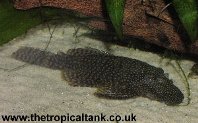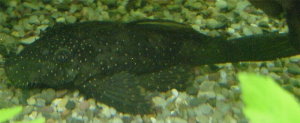|
|
Bristlenose Catfish


Left: Female © Sean Evans Right: contributed by Lisa Williams © Lisa Williams
|
| Common name: | Bristle-nosed catfish, Bristlenose |
| Scientific name: | Ancistrus species (see below) |
| Synonyms: | (none) |
| Size: | Up to 5" (12.5cm) |
| Origin: | South America |
| Tank setup: | Planted tank, with bogwood refuges. |
| Compatibility: | Community, may be territorial with other Ancistrus catfish, and sometimes with other bottom-dwelling fish. |
| Temperature: | 21-26oC (70-79oF) |
| Water chemistry: | Fairly soft, slightly acidic to slightly alkaline (pH 6.5-7.5), but this is not critical as
this fish is very hardy and adaptable |
| Feeding: | A good algae eater, this should be supplemented with algae wafers, sinking pellets,
green foods like lettuce and cucumber, etc.
They will also consume most other foods missed by midwater dwelling fish. |
| Sexing: | Males have the distinctive 'bristles' on their heads, which gives this genus its common name. |
| Breeding: | Will often spawn in the community tank. The male will guard the eggs. |
| Comments: |
The identity of the common bristlenose available in the hobby is uncertain, and was originally often cited as Ancistrus dolichopterus or Ancistrus temminkii,
but evidence seems to point to Ancistrus cirrhosus being more likely.
This fish is an ideal algae eater for the small to medium sized community tank. They do not grow too large,
they are busy algae eaters and they are generally hardy. They are peaceful, but territorial towards other bristlenose
catfish (and occasionally other bottom dwellers), so provide them with plenty of bogwood to rest on if you have several.
It is thought that the fish may use the bogwood in their diet, like fibre, by rasping at the wood, so always provide a piece
of bogwood in the tank. There are over 50 species of Ancistrus catfish, some of which are difficult to distinguish from each other.
|
[Home]
[Article Library]
[Fish Index]
[Tank Setups]
[Forum]
[Site Map]
|
|
|





